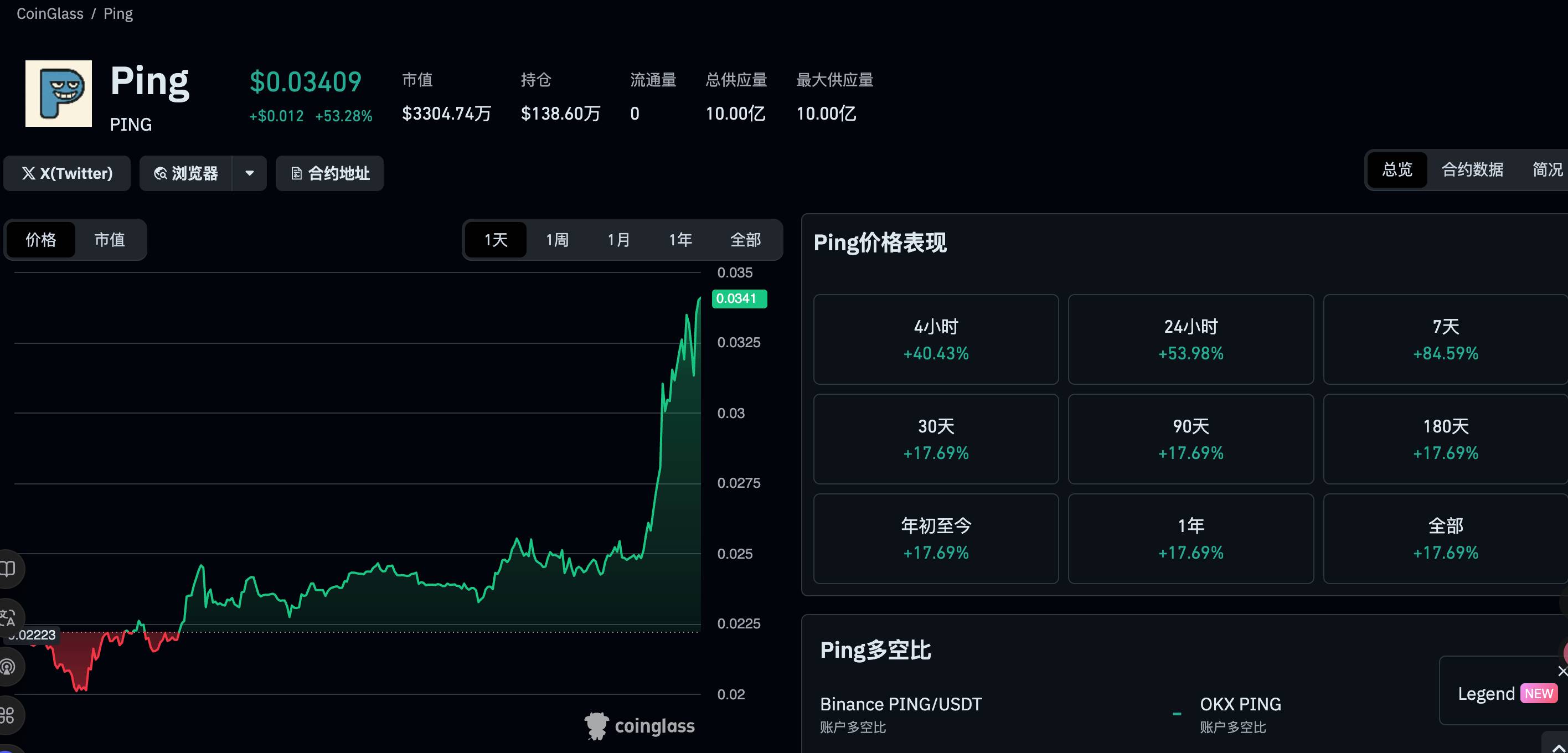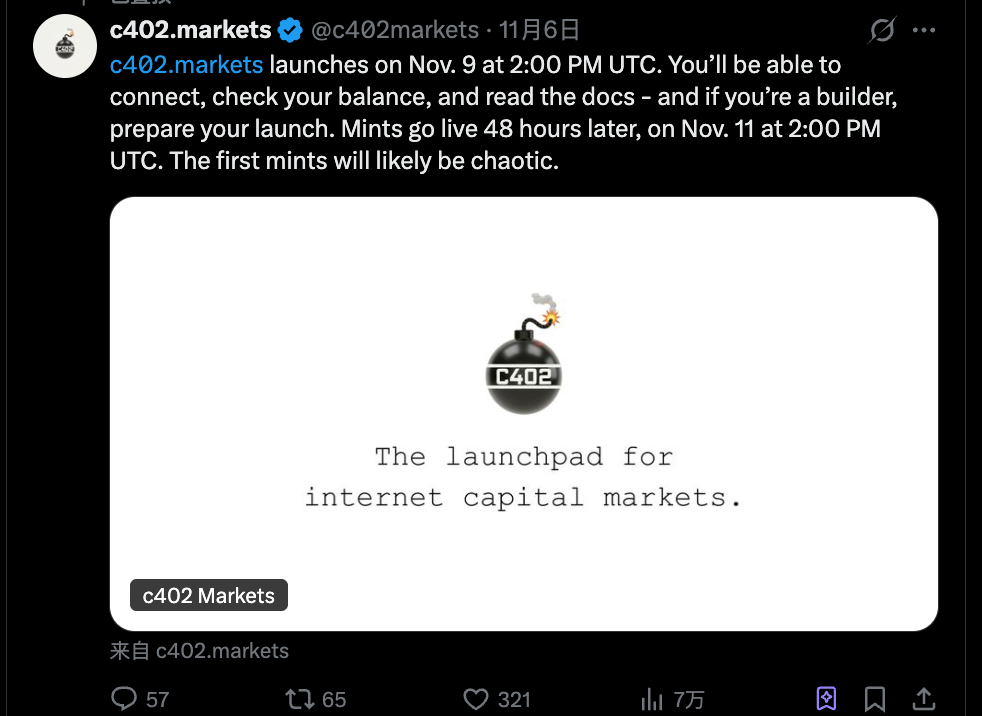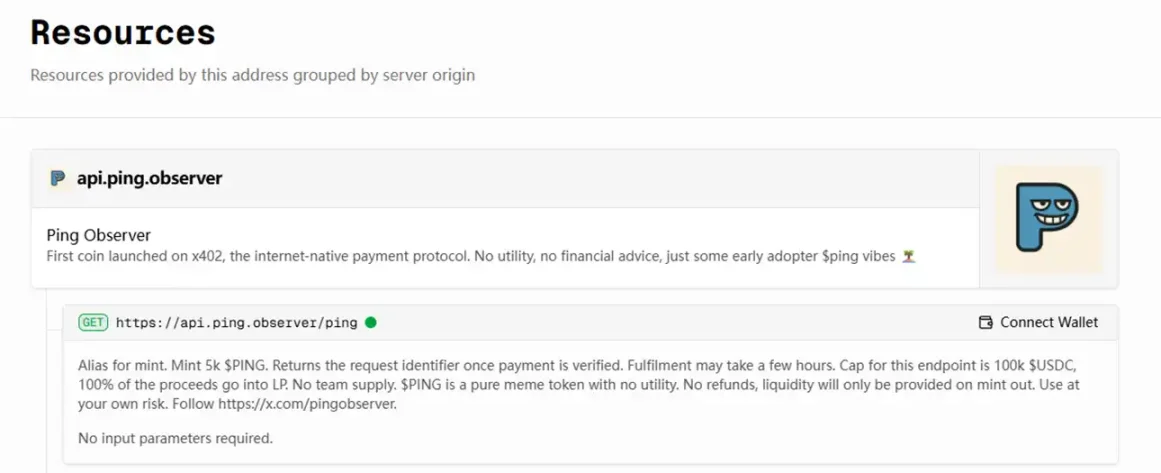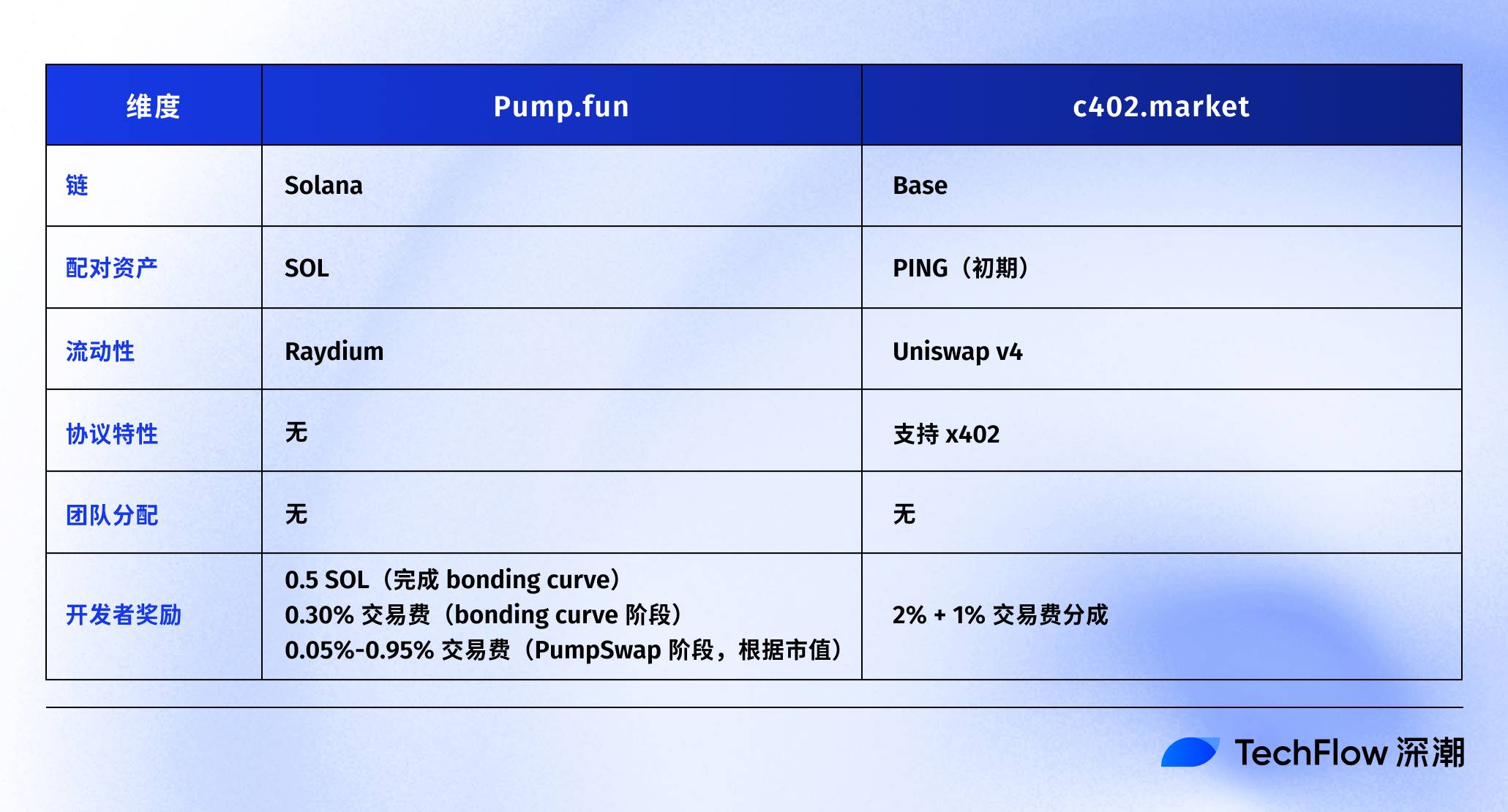c402.market is designed to incentivize token creators rather than just benefiting minters and traders.
Written by: David, Deep Tide TechFlow
The x402 narrative has been hot for half a month, but not many new assets have emerged.
The reasons are twofold: first, x402 leans towards payment services between AIs, which does not align with the typical "asset creation" approach common in crypto; second, most crypto projects surrounding the x402 protocol are focused on infrastructure, benefiting more from the hype of the technology narrative rather than making substantial product progress in the short term.
Interestingly, the first asset created based on x402, $PING (though it's a meme), has become the one to make waves.
On November 10, the official PING Twitter account @pingobserver announced the launch of the token launch platform c402.market based on the x402 protocol, expected to go live at 10 PM that night.
Upon the announcement, the price of the PING token quickly surged from its daily low, with a nearly 50% increase within 24 hours.

In short, the core mechanism of c402.market is: all new tokens issued on this platform will default to trading paired with $PING.
In other words, PING is no longer just a meme token in the x402 narrative; it has transformed into the "base currency" of the entire c402 ecosystem. To participate in new projects on the platform, you need to hold PING.
This is an old trick. The Solana ecosystem's Pump.fun made SOL a necessity for meme trading; various launchpads on the Base chain provided real use cases for ETH.
Now, c402.market is attempting to have PING play a similar role in the x402 ecosystem.
At this point in time, we are in a period of market divergence; some believe the market is in a bear phase, lacking new narratives and thus are not optimistic about new assets; while others think the altcoin season is arriving in a form different from what you expect, which inevitably brings localized opportunities.
With the trading data of the x402 protocol showing some decline, launching a more trading and asset creation-focused x402 concept launchpad might represent a localized opportunity in the current market.
However, can PING transition from a mere meme coin to a so-called ecosystem currency? For ordinary investors, what opportunities lie within, and what pitfalls are hidden?

Quick Review of x402 and PING
For those unfamiliar with x402, here’s a quick summary:
x402 is an open payment protocol launched by Coinbase in May 2025. It allows websites, APIs, and AI agents to directly use stablecoins (mainly USDC) for payments without the need for accounts, passwords, or API keys.
Its core mechanism is simple, as we introduced a month ago. In short, when you access a paid service, the server returns an HTTP 402 status code (a "payment required" code that has existed in internet protocols but has not been utilized until now), informing you how much you need to pay.
You send an on-chain payment using your wallet, then request access again, and the server verifies it to grant you access X402. The entire process can be completed within 2 seconds, with zero fees.
(For further reading: Google and Visa are both laying out plans; what investment opportunities are hidden in the undervalued x402 protocol?)
The rise of x402 is closely tied to $PING, as the latter has genuinely brought about a wealth effect.

$PING is the first token issued through the x402 protocol. Users do not need to register an account on the website; they simply visit a URL, receive a "402 payment required" prompt, pay a small amount of USDC, and upon re-requesting, they receive PING tokens.
This token itself doesn't have much utility; it’s more like a meme. However, it carries the aura of being "the first coin generated using x402," reminiscent of the previous wave of inscriptions, leading to significant speculation around it. At its launch, it surged 30 times, and its market cap once exceeded $60 million.
However, after PING gained popularity, the x402 ecosystem found itself in an awkward situation:
The protocol is cool, the technology narrative is strong, and the backing from giants is solid; but aside from PING, this meme coin, the ecosystem lacks more "assets" that people can engage with. x402 feels more like a payment infrastructure rather than a token issuance tool.
Most related projects are focused on AI Agent services and API markets, which are too far removed from the "speculative needs" of ordinary crypto investors.
The market needs a place that can continuously produce new assets and allow retail investors to participate in early projects. This is the backdrop for the emergence of c402.market.
You may not like this setup, but defining it purely as speculation without paying attention is another extreme behavior.
c402.market, the Pump.fun of the x402 ecosystem?
Opening the c402.market official website, you will see a concise and bold slogan:
"The mintpad for internet capital markets"
Indeed, it’s another familiar ICP narrative. By combining the grand terms "internet" and "capital markets," it attempts to cloak something that is essentially a token issuance platform in a revolutionary guise.
In simple terms, c402.market is a token launchpad based on the x402 protocol, where anyone can quickly issue tokens, and these tokens will automatically trade paired with $PING.
Before discussing the launch mechanism, it’s essential to understand what "c402 tokens" are. c402 is a self-innovated token standard, essentially an ERC-20 token that supports the x402 protocol and has a built-in public minting mechanism. The official term for it is "internet coins."
This means that tokens issued on c402.markets are not just ordinary ERC-20 tokens but are inherently supportive of the x402 payment protocol.
Theoretically, these tokens can be directly used in payment scenarios for AI Agents or any application that requires the HTTP 402 status code to trigger payments. However, in reality, most people are more concerned about its speculative value rather than its technical features.

The launch mechanism of c402.market heavily borrows from the "Bonding Curve" model of Pump.fun but has made some adjustments. The total supply of each token is fixed at 1 billion, with no team allocation and no reserved shares.
According to the official documentation, the distribution structure for a launched token is:
49% distributed through public minting, with each mint requiring a payment of 1 USDC
49% automatically used to provide liquidity
2% as developer rewards
Minting process:
Create a token: Anyone can create a token by providing a name, code, description, and image. Creating a token requires a "spam prevention" fee of 1 USDC.
Wait for minting to start: After the token is created, it will automatically begin minting after a fixed period (interestingly, the official documentation obscures the specific time with █, which could range from a few minutes to over ten minutes; the exact timing may need to wait until the product officially launches).
Rush phase: Users mint tokens by paying 1 USDC. The number of mints is limited.
Automatic listing: Once all minting shares are claimed, the collected USDC will be automatically processed.
The principle of PING pairing: USDC → PING → Liquidity Pool
This is the most critical part of the entire mechanism and the core logic through which PING can benefit.
According to the project description on GitHub, when a c402 token is successfully minted, all collected USDC will be used to purchase the paired token specified at creation (initially only supporting PING), and then, along with the remaining 49% of the token supply, it will be added to the liquidity pool and locked.

For example: Suppose someone creates a token named $COIN and chooses $PING as the paired asset. The minting phase requires a certain number of transactions to be completed; let’s assume it’s 10,000 transactions; that would be 10,000 USDC.
Minting phase: Users rush to mint using USDC, collecting 10,000 USDC.
Automatic exchange: This 10,000 USDC is automatically converted to $PING via Uniswap.
Providing liquidity: The acquired PING + 490 million $COIN (49% of the supply) are added to the Uniswap v4 liquidity pool and permanently locked.
Developer rewards: 20 million $COIN (2% of the supply) are given to the token creator.
What does this mechanism mean for PING?
Whenever a new token is successfully minted on c402.market, a forced buying pressure of USDC → PING is generated. If there are 10 projects minting daily on the platform, each collecting 10,000 USDC, that results in a daily buying pressure of 100,000 USDC for PING.
This may also explain why the launch of c402.market caused the price of PING to surge by 50%—the market is pricing in the potential for sustained buying pressure or positive expectations for the ecosystem.
Who is making money?
The fee structure of c402.market is as follows:
For Minters:
Each mint costs 1 USDC
Of this, 2% is the platform fee (0.02 USDC)
Gas fees (which are quite cheap on the Base chain, but still need to be paid)
For Token Creators:
A "spam prevention" fee of 1 USDC is paid when creating a token c402
They receive 2% of the token supply as a reward
They earn a 1% share of the transaction fees from the liquidity pool (part of which is paid in tokens) c402
The documentation also mentions that if you build your own frontend and set yourself as a referrer, you can take the 2% platform fee, allowing for zero platform fee minting.
Although initially only PING is supported as a paired asset, the c402.market GitHub repository has already opened a submission mechanism for "paired token whitelisting" github. Any project can submit a PR to apply for their token to be added to the pairing options, provided they have sufficient (locked) liquidity on Uniswap v3 or v4, and that the JSON format and image specifications meet the requirements; after passing the review, manual whitelisting on-chain is also required.
This means that in the future, c402.market may support USDC, ETH, or other tokens as paired assets, not just PING. But at least in the initial launch phase, PING is the only option.

It can be seen that c402.market's mechanism design is more inclined to incentivize token creators, rather than just benefiting minters and traders. However, those in the know understand that this could also lead to the platform being flooded with a large number of low-quality projects, as creators have economic incentives to continuously issue new tokens.
As of the time of writing, c402.market has just announced its upcoming launch (at 10 PM on November 10). The official documentation still has many details obscured by █, including specific minting counts, time windows, and "bribery mechanisms."
These may be to prevent bots from preparing in advance, or the team may not have finalized them yet.
The real test will come after the first batch of projects goes live, the first batch of liquidity is formed, and the first batch of traders begins to engage in speculation, allowing us to see how this mechanism performs in practice.
Ultimately, asset creation and new token launches are always themes in the crypto market; it has just shifted to the x402 concept. In the current environment with not many new narratives, cautious participation may be a pragmatic choice.
免责声明:本文章仅代表作者个人观点,不代表本平台的立场和观点。本文章仅供信息分享,不构成对任何人的任何投资建议。用户与作者之间的任何争议,与本平台无关。如网页中刊载的文章或图片涉及侵权,请提供相关的权利证明和身份证明发送邮件到support@aicoin.com,本平台相关工作人员将会进行核查。




